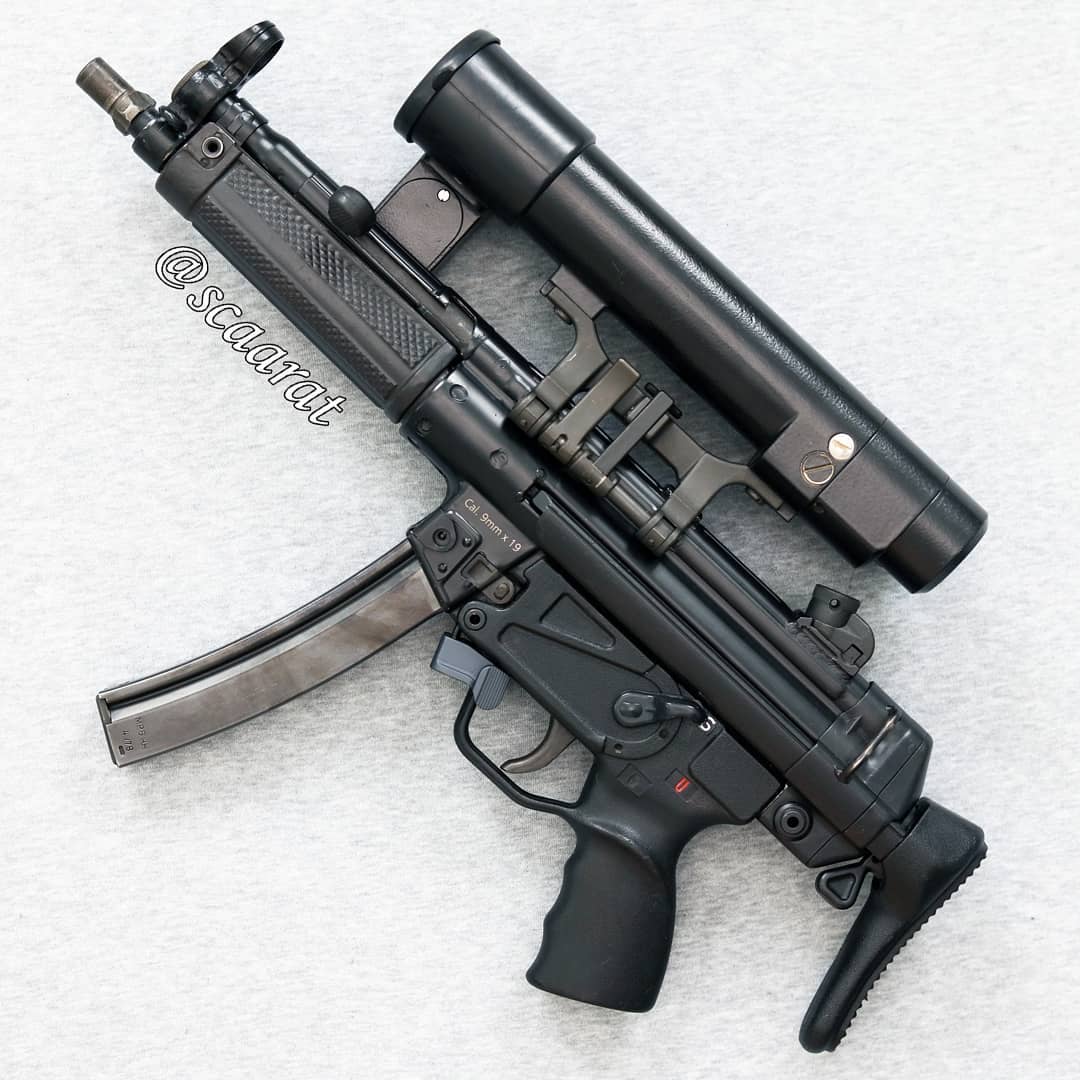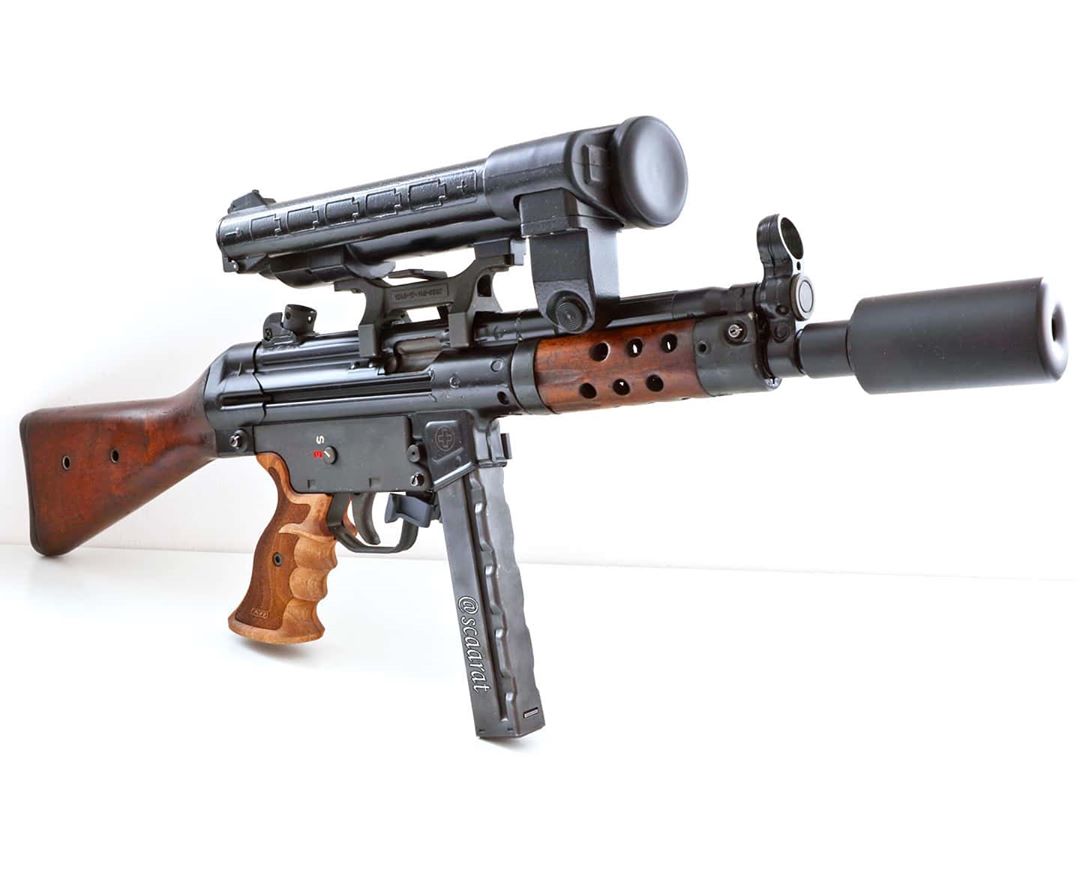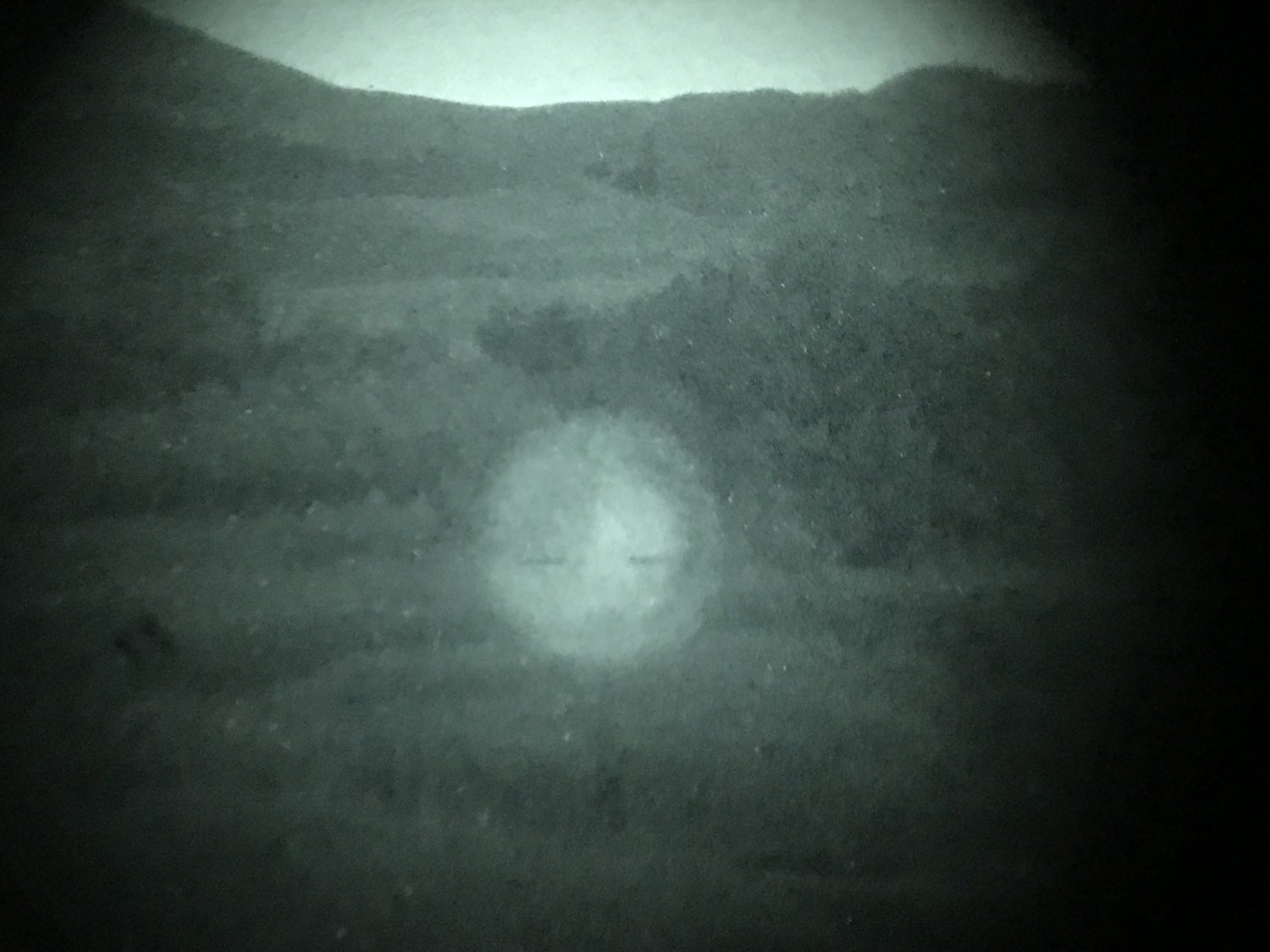

This idea came about during a TFB work chat. Will P’s friend, Kevin Z, was curious if he could project an illuminator through a scope and aim with it. Hmmm, interesting. Could this work? Some of the TFB staff was skeptical. I was intrigued and it sounded like a fun experiment. I had some ideas and it is not totally crazy. Could an infrared projected reticle actually work? Let’s find out, FOR SCIENCE!!
Aiming With Light (Not A LASER)
Aiming with light is not a new or alien concept. No, I am not talking about a LASER. But using collimated light as an aiming reference for shooting a gun. When Will P posted the idea, I immediately thought of two examples that could make this work. The first was the urban legend of the SAS MP5s with huge lights mounted on them. Some claim that the SAS used Maglites focused down to the tightest spot and they used those like lasers. Here is one such weapon light but it wasn’t a Maglite.
My friend Gregor aka @Scaarat in Austria has a Hensoldt ZPP. It is a giant flashlight, almost as big as the MP5 itself, that projects a circle with a black shadow dot in the center.



Below is a video of Gregor briefly explaining the Hensoldt ZPP and more importantly showing you what the projected reticle looks like.
https://www.instagram.com/tv/BrNmxH_h3a6/
Shining Light Through A Scope
Now shining a light through a scope has its uses as well. This is the second idea that came to mind when Will P posted Kevin’s conundrum. Using a light to project the reticle of your scope so you can properly level your scope. I have actually tried this many years ago. And while the video below is shining the light backwards through the scope, the idea is still the same.
Infrared Projected Reticle

There were some immediate questions that came to mind before I tested this.
- Would the position of the light affect the position of the reticle and change POA?
- Does the type of light matter, LED vs Laser illuminator?
- How bright would the light be? Would the glass in the scope reduce the light making it useless?
- How would changing the magnification of the optic affect the projected reticle?
- Does the style of optic make a difference for better results?
- Are some reticles better than others?

Old ATN IR Illuminator used to create Infrared Projected Reticle
Would the position of the light affect the position of the reticle and change POA?
So from my test, moving the illuminator around did not affect the reticle at all. The light is shining through the optic and the reticle casts a shadow. So I thought shifting the light would cause the shadow to move. No, it does not affect the projected reticle at all. That was a relief because I was not sure if I could get the light perfectly aligned with the center of the optic’s glass.
Another concern I had was how does the light affect the POA/POI of the scope and gun? I had a conversation with my gun buddy, Kythe, and we came to the conclusion to zero a laser to the optic of choice. Then see if the infrared projected reticle holds the same zero with the IR laser. Success. No POA shift at all.
Does the type of light matter, LED vs Laser illuminator?
I used my old ATN IR illuminator for my initial test and mounted it on a short riser. I aimed it through my Elcan Specter. It worked like a charm. But then I wondered if different IR illuminators would work as well? The ATN illuminator is an old-style IR LED. I tested the following IR illuminators:
- SureFire X400V Vampire (LED)
- Modlite IR 850nm and 940nm (LED)
- DBAL D2 (LED)
- DBAL A3 (laser)
The only light, other than the ATN illuminator, that seemed to work well was the Modlite IR 850nm head. The SureFire X400V LED did not work at all. The beam was too narrow and did not illuminate the entire Elcan reticle. Surprisingly, the DBAL D2 IR illuminator is really good but terrible for this type of use. The same goes for using the DBAL A3 laser illuminator.
How bright would the light be? Would the glass in the scope reduce the light making it useless?
As expected, the light shining out of the optic is not as bright as I would like it to be. While the ATN is useable in this type of experiment out to 100 yards, it was difficult to discern the crosshairs out to 200 yards and 300 yards was just nearly impossible. However, with the Modlite IR 850nm, it is a beast of a light. It is a lot brighter and when I got the light positioned properly, I could see the reticle out to 300 yards.
In the video I posted earlier, the green phosphor night vision test of the laser against the infrared projected reticle, the ambient light of the neighborhood overwhelms and washes out the infrared projected reticle. I had to switch the Elcan to 6x so it tightens the IR light and made it possible to see the projected reticle.
While I said earlier that the position of the IR light does not matter from a POA shift perspective, it does matter when trying to project the reticle perfectly. I noticed when I was using the Modlite IR 850 I am holding it like a handheld flashlight so I would have to minutely adjust the angle of the IR illuminator just to get the reticle to show up.
How would changing the magnification of the optic affect the projected reticle?
The Elcan has a simple switch to flip from 1.5x to 6x. When I did this the illuminator beam becomes tighter. When I did this indoors, I was unable to see the reticle. However, at further distances, I can see the reticle. By tightening the illuminator beam, it can shine at further distances as well. We saw this with the ATN illuminator. At 1.5x on the Elcan, it was difficult to see the reticle out to 300 yards. But flip the switch to 6x then it was useable. This sort of leads us into the next question.
Does the style of optic make a difference for better results?
While this worked with the Elcan/ATN illuminator combination, I did not have good success with my Vortex Diamondback Tactical 6-24×50. I had to play with the diopter and parallax adjustment to see the reticle and after all that, it was not that useful. When I switched to high magnification, the beam became a tight circle. Not quite a laser as it would probably be an 8″ circle at 100 yards but it could be used as an aiming device to some degree. What made the Vortex Diamondback Tactical difficult to use was the fine crosshairs.
Are some reticles better than others?
Most definitely yes. The best reticles I tested were from the Vortex Strike Eagle 1-6 and the Primary Arms GLx 2X Prism. Both of these optics have a horseshoe style reticle. They cast a bigger shadow that is easier to see. The GLx 2x Prism has a smaller horseshoe so it would be easier to make a more precise shot.
Elcan w/ ATN illuminator



Elcan at 6x magnification shined out to 300 yards.
Primary Arms GLx 2x Prism w/ ATN Illuminator 

Zoomed in with 3x magnifier.
Vortex Strike Eagle 1-6x w/ ATN illuminator

Vortex Diamondback Tactical 6-24×50 w/ ATN illuminator at 6x magnification
This one is really hard to see. You can sort of make out the shape of a crosshair.


Final Thoughts On Infrared Projected Reticle
This was a fun idea to put to the test. I had some doubts but I dispelled them. I even proved some people wrong. However, we need to take a step back and ask ourselves “Is this practical?”. Given Kevin’s unique case use where using aiming lasers are illegal in Germany then this is a possible workaround. I am not sure if it is legal to hunt at night in Germany so this entire solution may be academic at this point in time. For most purveyors of shooting in the dark, this is not that practical. Ambient lighting is ever changing. When I tested the projected reticle, the moon had not yet risen. But as the night progressed into my testing, the moon did rise over the horizon and I could tell that such a bright source of light would wash out the low intensity of the ATN illuminator.
Mode of operation is another critical issue. I do not have a tape switch long enough to go from a light mounted above my charging handle, to reach all the way to my support hand. I suppose I could position a tape switch to the pistol grip and activate the light with my fire control hand. Also, you have a flashlight shining into the back of your scope. There is a lot of light leaking out and can affect your night vision. If you were behind a gun with this setup, the light splashing back into your nods would not be great. They would dim down and you would not see as much. You would need to wrap the gap between the light and the scope. Also, you now have a scope that you cannot look through. In order for this setup to work, I had to shift my optics really far forward. This would require you to rezero your gun and in some cases you might not have enough rail space.

Another dose of reality is that the infrared projected reticle does not work well with high magnification. So why not just use the IR flashlight to illuminate downrange and look through a good red dot or holographic sight? The entire time you are waving an infrared projected reticle, you are only looking at a 1x image through your night vision goggles. Better off getting a laser and using that to aim with if you don’t like looking through an optic with NODs.
 Your Privacy Choices
Your Privacy Choices
